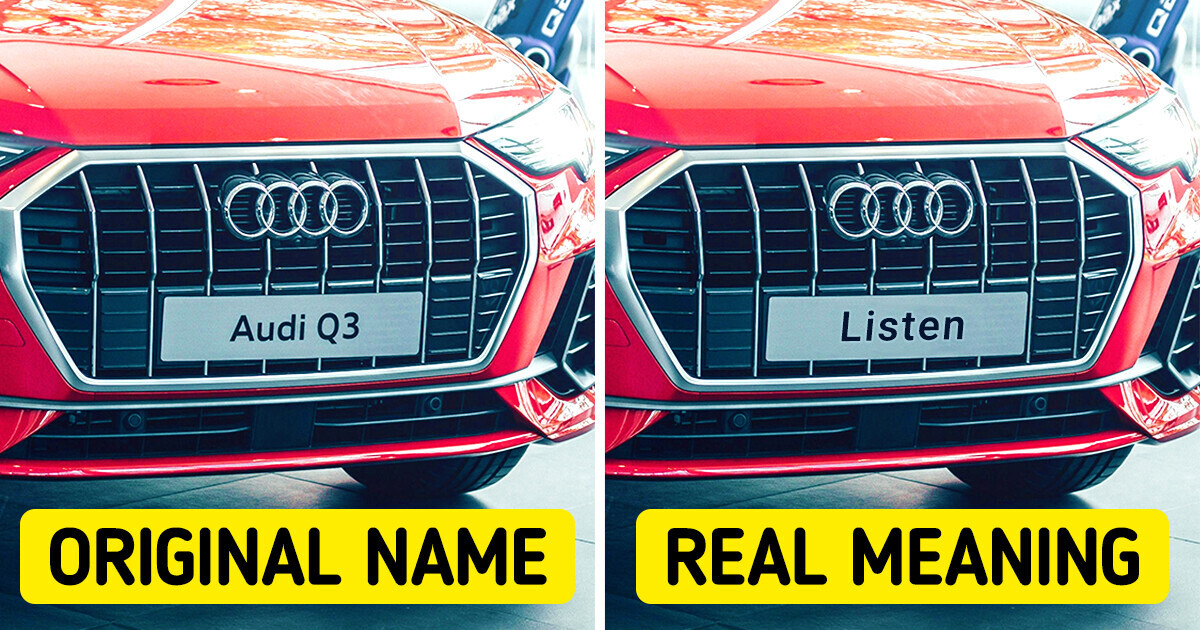My Husband Unconsciously Called Me Another Woman’s Name — I Was Utterly Shocked to Discover Who It Was


Every time you drive down the road, you pass dozens of car brands without giving a second thought to what their names or logos might mean. But what if we told you that behind every shiny badge and clever name lies a story, a history, or even a hidden message?
From animals to initials to downright quirky inspirations, car brands are like secret storytellers. Let’s buckle up and take a drive through the fascinating etymology of car names and logos. By the end of this ride, you’ll never look at cars the same way again.
Ever wondered what “Audi” means? If you’re fascinated by luxury cars and attracted to vehicles marked with the iconic four rings, this is the story you didn’t know you needed to read. But, to understand the meaning of the name, we first have to go back to the beginnings of this brand that transformed the automotive world.
August Horch, the visionary founder, began his career in the automotive world in 1899 with his first company, “Horch & Cie.”, in Cologne, Germany. But like any good corporate drama novel, Horch had his differences with the partners, which led him to abandon his own company in 1909. Of course, he wasn’t going to sit idly by, so he started another company. The problem? He couldn’t use his last name because it was already registered.
At that point, a movie-worthy moment comes into play. At a meeting with business friends, one of them remembered his son, a little genius who was studying Latin in the corner of the room. The boy, probably more interested in impressing than in the car business, suggested using the Latin term for “Horch,” which, in German, comes from the verb horchen, meaning “listen.”
Thus, “Audi” was born. The fun fact? The word also connects to the Latin phrase “audiatur et altera pars”, which means “listen to the other side.” Something poetic for a brand that was looking to make itself heard in the competitive world of cars.
Audi cars did not take long to make noise, literally and figuratively. Within a few years, they were conquering the Alps at full speed, winning prestigious competitions between 1911 and 1914. Although Horch left the company, Audi continued to grow to become synonymous with luxury and performance.
Audi logo from 1995
Audi logo from 2009
And what about the famous logo? The four rings are not just a sleek design; they tell the story of a strategic union. In 1932, four independent manufacturers — Audi, DKW, Horch, and Wanderer — joined together to form Auto Union AG in response to the economic challenges of the time. Each ring represents one of these brands, and together they symbolize the strength of the collaboration.
Over time, the logo evolved, but those four rings remained the visual essence of the brand. Today, they are a reminder of how togetherness can create something greater than the sum of its parts.
From humble beginnings to becoming one of the most recognized luxury brands, Audi has listened to the needs of the market, as its name suggests. Its history speaks not only of innovation and success, but also of how a small detail — like a Latin name — can leave an indelible mark.
So, the next time you see an Audi, you won’t just be admiring an elegant car; you’ll be looking at a piece of history that began with a boy studying Latin in a corner. Who knew greatness could be born from something so simple?
Before we talk about the name, let’s go back a bit in history.
Toyota, one of the most recognized brands in the world, has an interesting story behind its name. It all starts with the Toyoda family, who founded the company. Originally, the company bore the name “Toyoda,” which was spelled with ten strokes in Japanese. However, in a curious twist, the name was changed to “Toyota,” with only eight strokes, as the number eight is considered a lucky number in Japanese culture. This simple modification not only had cultural significance but also made the name sound more harmonious and easier to pronounce.
In addition, the name “Toyoda” means “fertile rice paddies,” which could have limited the perception of the company to something related to agriculture and old-fashioned. By changing the name, Toyota freed itself from those connotations and came to be seen as an innovative and modern company. This decision also symbolized the company’s expansion from a family business to a far-reaching corporation and a globally recognized brand.
The history of this change began in 1933, when Toyoda Automatic Loom Works, a company initially dedicated to the manufacture of looms, created a department dedicated to the production of automobiles. Thus was born the forerunner of the Toyota Motor Corporation.
In 1936, the automotive division of Toyoda Automatic Loom Works organized a design competition to create a logo to represent the new line of cars. The winning entry was a circular design incorporating the Japanese characters for “Toyota,” which was chosen from more than 27,000 entries. This logo not only symbolized the company’s new phase but also marked the transition from a familiar family name to a simpler, more distinctive brand.
In 1937, after Kiichiro Toyoda, the founder, officially registered the name “Toyota”, the company began operating as Toyota Motor Company. Thus, the brand we know today as Toyota began its path toward internationalization.
Toyota logo since 1989
The Toyota logo, which has evolved, is another fascinating aspect of the brand. The current logo design is composed of three ovals, symbolizing the heart of the customer and the heart of the company, which overlap to represent a relationship of mutual trust.
In addition, the outer circle symbolizes Toyota’s globalization and its commitment to innovation and quality. The design also forms the letter “T” for Toyota, a creative way to integrate both the company’s name and product into a single symbol.
In short, the name “Toyota” is not just a matter of branding, but is deeply connected to the company’s history, culture, and vision. It is a testament to how small changes can have a big impact on a brand’s identity and its relationship with the world.
If you’ve ever wondered what “Volkswagen” means in English, the answer is quite simple, but with a rich history behind it: “The people’s car”. The German word “Volks” translates as “people”, while “Wagen” refers to “wagon” or “car”. And so was born the idea of a car accessible to all, with the mission of democratizing mobility.
The history of Volkswagen does not begin with a simple car factory. It all began in 1934, when development work on the first model, the famous “Käfer” (or Beetle, as we know it today). In 1937, the company was formally founded under the name “Gesellschaft zur Vorbereitung des Deutschen Volkswagens mbH”, which translates as “Company for the Preparation of the German Volkswagen Ltd”. In 1938, the company changed its name to “Volkswagenwerk GmbH”, and built its main plant in what is now Wolfsburg.
For some time, the company drifted into the production of military vehicles. And then, the British asked Volkswagen to begin production of its original model, the Volkswagen saloon, at the end of 1945. With the iconic Type 1 model (the famous Beetle) and the Type 2 (Transporter) of 1950, Volkswagen became a symbol of Germany’s economic miracle. From the 1960s onwards, the company grew exponentially, driven by its focus on exports and flexible production, introducing trend-setting models such as the Passat, Scirocco, Golf, and Polo.
As for the logo, few know it as well as car enthusiasts themselves. The iconic Volkswagen logo, depicting the letters “V” and “W” interlocked, symbolizes the name “Volkswagen.” The blue and white colors are not a simple aesthetic choice: blue conveys excellence, reliability, and class, while white is associated with purity, nobility, and charm.
Since its creation in 1937, the logo has undergone several modifications but has always maintained that distinctive identity that has been key to the brand’s global recognition.
To talk about Volkswagen is also to talk about how the brand has made efforts to confront its past. Although its origins are deeply linked to a dark period in history, the company has sought transparency and repair over the years, acknowledging its history and taking steps to avoid repeating the mistakes of the past.
Today, Volkswagen presents itself as a global leader in the automotive industry, standing out for its vision of the future, which includes advances in electric mobility and digitalization. As it continues to expand its presence around the world, the brand is not only staying true to its roots but also reinventing itself, adapting to the demands of a world seeking more sustainable and technologically advanced solutions.
We all know it! Many of us have ridden in one, or at least dreamed about it. But have you ever wondered what that name that sounds like speed and luxury means? Sure, we’re talking about BMW, the three letters that get car fanatics around the world buzzing. But beyond the shiny logo and the perfect curves of its models, where does this name come from, and what does it stand for?
BMW, those three iconic letters, is an acronym for “Bayerische Motoren Werke GmbH”, which translates as “Bavarian Motor Works”. This name is no accident: it traces its origins to Bavaria, a region in Germany known for its history and, of course, its innovative spirit. The name itself reflects its beginnings as an engine manufacturing company. In its early days, before it dreamed of luxury cars, BMW made aircraft engines — nothing less!
In 1913, BMW began its journey as “Rapp Motorenwerke”, a company dedicated to the manufacture of aircraft engines. At that time, cars didn’t rule the roads; if you wanted to travel long distances, you most likely took a train. But surprise! BMW’s story didn’t stop there. In 1916, after the bankruptcy of its allied factory, BMW reorganized and, in 1917, changed its name to Bayerische Motoren Werke GmbH. And that’s when the legend begins!
A few years later, BMW took a radical turn. Instead of aircraft engines, the brand turned to producing brakes for trains. And although this gave them an economic respite, the real transformation would come a couple of years later. In 1922, Camillo Castiglioni, an aviation pioneer, bought the company and turned it into what we know today as BMW AG. And yes! Although the factory had changed ownership several times, it never lost its essence!
BMW logo from 1931
You already know, BMW’s name pays homage to its place of origin: Bavaria. But what many don’t know is that the famous BMW logo has a history also linked to the region. Although there is a popular legend that says that the logo represents an airplane propeller (a theory that, although exciting, is not entirely true), in reality, the colors of the logo come directly from the flag of Bavaria. What a patriotic detail! The combination of white and blue, which by the way is so characteristic, is meant to symbolize the Bavarian flag, which bears these colors in its coat of arms.
Speaking of the logo, the story behind it is as fascinating as its design. Initially, in 1917, the BMW logo was inspired by the circle of the old “Rapp Motorenwerke”, and featured stylized airplane propellers. But it’s not a simple play on colors! In its original form, the blue and white colors represented those of the Bavarian flag, and the circular shape evoked the blades of an airplane propeller. Over time, the logo changed, but the essential was always the link to aviation and the Bavarian region — imagine this symbol still being the same but with a modern twist!
Today, BMW is synonymous with elegance, performance, and cutting-edge technology. With vehicles that stand out around the world for their design and performance, the brand has managed to stay true to its origin, while adapting to new times. The logo has changed several times but has always maintained its deep roots in Bavaria, and the brand name continues to evoke that history of engines, innovation, and luxury that began more than a century ago.
When we talk about Hyundai, the first thing that comes to mind is a modern and stylish automobile, but have you ever wondered what the name means? The word “Hyundai” comes from the Korean language and translates roughly as “modernity”. A name that not only reflects its origin, but also the philosophy with which the company was established in 1967.
The vision of its founder, Chung Ju-Yung, was clear: to offer something innovative, different, and of quality. Thus, Hyundai Construction was born, and over time, the brand became synonymous with vehicles that bring new ideas and new possibilities, as its slogan says: “New thinking, new possibilities”.
Hyundai’s story is not only measured in miles driven but in the path of perseverance that its founder, Chung Ju-Yung, traveled. Born in 1915 in North Korea to a peasant family, Chung left home at the age of 18 to seek a better future in Seoul. His first attempt as an entrepreneur was not easy, and he faced failures, such as the closure of his rice store.
But it was those failures that gave him invaluable lessons. Eventually, his ability to reinvent himself led him to create Hyundai, a company that started in construction and has now become one of the largest vehicle producers in the world. From poverty to the top, his story is an inspiration.
Since Hyundai entered the U.S. market in 1986 with its Excel model, the brand has been synonymous with opportunity and quality for those seeking efficient cars without sacrificing style. In just seven months, Excel achieved record sales, and since then, Hyundai has continued to grow, offering cars that are not only affordable but also compete with the biggest brands in terms of design and technology.
Hyundai logo since 1990
The Hyundai logo, with its sleek, modern “H” tilted to the right, symbolizes much more than just a letter. This design reflects movement, something the brand has maintained over the years. If you look closely, you’ll notice that the logo also suggests a handshake between two people, representing Hyundai’s commitment to its customers — a subtle but powerful detail!
In addition, the oval surrounding the design reflects the global vision of the brand, which has a presence in more than 190 countries, always committed to offering cars with efficiency, style, and, above all, affordability.
Today, Hyundai not only continues to innovate in terms of design and technology but also leads the way in sustainable mobility. The brand is investing heavily in electric vehicles and hydrogen cars, aiming to revolutionize the automotive industry once again. With research centers around the world and a vision ranging from greener vehicles to autonomous cars, Hyundai is prepared for the future.
If you are a fan of this brand, you probably already have an idea of its legacy and prestige. But what is behind the name that makes everyone, from urban drivers to sports car lovers, feel identified?
Although we all know Chevrolet by its nickname “Chevy”, the full name has an interesting history and a touch of nostalgia. It all began in 1911, when a man named Louis Chevrolet, a passionate driver and mechanic, became one of the founders of the brand. The other co-founder, William Durant, was so impressed by the sound of Louis’s surname that he suggested they use his name for the car brand. Thus, the famous “Chevrolet Motor Car Company” was born.
Louis Chevrolet was born in Switzerland in 1878 and spent much of his youth in France. Although the brand bears a name with Swiss roots, its association with the United States is so strong that many forget its European origins. Before being recognized for his link to the famous car brand, Louis was a prominent racing driver and mechanic. After moving to the United States in 1901, he worked in various car factories and honed his skills in mechanics.
It was in the world of racing that he began to shine. Louis Chevrolet achieved amazing feats, such as defeating famous driver Barney Oldfield in his first race, which catapulted him to fame. Soon, his talent led him to drive for brands such as FIAT and Buick, where he continued to break records on tracks across the country. It was during this period that he met William Durant, who, influenced by racing, decided to partner with him to create the Chevrolet brand.
Chevrolet logo from 1913
In 1914, the company introduced its most famous logo: the “bowtie”. Although historians do not agree on the exact origin of the design, it is said that Louis Chevrolet was inspired by a wallpaper he saw in a hotel in Paris or that the figure resembles the Swiss cross, a tribute to his family heritage.
This logo, with its gold and yellow design, symbolizes strength and enthusiasm, and over the years it has varied in its colors, going from a black and white scheme to the current shades we know today. The legend behind this logo lives on, showing how a simple and powerful idea can become the hallmark of a company that has been in the hearts of millions of drivers around the world.
Today, Chevrolet is not just a name, it is a vital part of the global automotive landscape. From the earliest days to the creation of the iconic Corvette in the 1950s, Chevrolet has left an indelible mark on the industry, combining innovation with tradition. Models like the Chevrolet Camaro, which was the pace car for the 1967 and 1969 Indianapolis 500, remain part of the brand’s legacy, and many fans continue to collect cars from that era.
So the next time you climb into your Chevy, remember that you’re not just driving a car, but a piece of history named after a man whose legacy continues to accelerate the future of motoring.
Now, let’s talk about Volvo—a name that has everything to do with rolling... but not in the way you might think.
The name “Volvo” comes from the Latin verb “volvere”, which means “to roll.” But long before it was known as the iconic car brand we recognize today, this word had its roots in a much earlier product—iron ball bearings!
In 1911, Volvo became a registered trademark, and, believe it or not, the name was originally used for a different kind of product, showcasing the company’s engineering excellence. Today, it’s synonymous with cars, but it’s fascinating to know that its origins rolled out long before the company even built its first vehicle.
When you think of Volvo, what comes to mind? The safety of the cars? The classy design? The logo, of course! It’s everywhere—on vehicles, accessories, and even on a range of tools. But if you’re thinking that the Volvo logo looks like a symbol of masculinity, you’re not entirely wrong, though it’s not as straightforward as it seems.
The logo’s design is rooted in the alchemical symbol for iron, a metal that’s been crucial to Swedish industry. While it might seem like a nod to Mars, it was meant to celebrate Sweden’s legacy in metallurgy. The symbol, a circle with an arrow, speaks to the strength of the iron, a metal known for its durability, and perfectly represents the brand’s focus on resilience and reliability.
Over the years, the Volvo logo has undergone a few updates, but the symbol of strength remains a constant. And the blue hue? That’s for stability and trust. The chrome? It’s all about sophistication and class. Together, they form an emblem that’s as enduring as the brand itself.
So, next time you see that circle with the arrow, remember that it’s more than just a logo. It’s a symbol of strength, a tribute to Sweden’s rich industrial past, and a nod to a future that’s all about innovation, reliability, and safety. Buckle up—it’s going to be a fun ride!
Imagine getting into a car and, as you drive, feeling the roar of the engine reflect the strength and speed of a lion. Now, imagine that same lion has been with you for over 150 years. Peugeot has not only built cars but has forged an emblem of endurance and agility in the automotive world. But have you ever wondered where this powerful symbol comes from?
The story begins long before Peugeot became a world-renowned brand for its cars. In 1819, a visionary named Fritz Peugeot (yep, that’s why the brand is called that) introduced a cold-rolling process for steel, allowing for the creation of precision tools.
Among his first achievements was a saw of exceptional quality that, thanks to its durability and precision, conquered the market. That very saw was awarded a gold medal in 1819, which foreshadowed the success that the brand would have in the future.
Peugeot logo from 1810
But the name “Peugeot” was not always associated with cars. The Peugeot family began as manufacturers of metal tools. In 1850, the Peugeot brothers, with the great success of their saws, decided to give their brand a touch of identity and chose a very particular symbol: the lion.
Why a lion? Because like their saw, the lion is strong, fast, and has an imposing “bite”. In addition, the lion evoked the characteristics of the steel they worked with: agility, resistance, and precision. From then on, the lion was registered as the official emblem of the brand, and its design was engraved on the saws from 1850.
Over time, this lion evolved but always maintained its essence: a symbol of strength and distinction. Peugeot moved from making tools to producing bicycles, and then in 1889, it began to venture into the world of automobiles. It wasn’t until 1898 that Peugeot opened its first car factory, one that, like the brand itself, was destined to become an icon.
The famous lion logo is not just a simple drawing; it represents the evolution and unwavering character of the brand. Over the years, the lion was modernized, adding details such as the paws that show its power and the black shadow that gives it a touch of mystery. Today, Peugeot is not only known for the quality of its vehicles but also the elegance and symbolism of its emblem.
What is hidden behind the name and logo of Mercedes-Benz, that brand that has conquered the world with its luxury and elegance?
The name “Mercedes” did not come out of nowhere. In fact, it is the result of a rather curious mix. Mercedes-Benz is a combination of two names: Mercedes Jellinek, the daughter of businessman Emil Jellinek, and Karl Benz, one of the founders of the brand.
But, to understand it better, let’s go back a little.
Mercedes Jellinek, one of the people after whom the brand was named
The journey began in 1886, when Karl Benz patented the first motorized automobile, and Gottlieb Daimler developed his four-wheeled motorized carriage. Although both worked separately at the same time, they did not know each other.
Years later, when Emil Jellinek joined the company and helped develop the 35 PS Mercedes model in 1900, he decided to name this innovative car after his daughter Mercedes. This name, which in Spanish means “mercy” or “mercy,” symbolized elegance and grace, characteristics that the vehicle perfectly embodied.
As time went by, “Mercedes” became a registered name by the company in 1902, and it began to be used not only to name cars but to give the brand a unique identity. Although the company was originally called Daimler-Benz, it soon became clear that the name “Mercedes” would be the one that made the difference.
Mercedes-Benz logo from 1902
Mercedes-Benz logo from 2010
Now that we know where the name comes from, let’s talk about the logo, which is almost as famous as the brand itself. The iconic three-pointed star, inside a circle, has a very deep meaning.
Each point of the star represents a key area that the Mercedes-Benz brand is committed to revolutionizing: the land, the air, and the sea. In other words, the star symbolizes the brand’s mission to create vehicles that can master any terrain and overcome any challenge.
This logo not only reflects the vision of the founder but also encapsulates the innovative spirit that has accompanied Mercedes-Benz throughout its history. From its early days to becoming the most recognized luxury car manufacturer, the star has witnessed the most important advances in the industry.
The brand has left an indelible mark on the automotive industry, with decades of cars that have conquered everything from American highways to roads around the world. But beyond being synonymous with rugged, reliable cars, have you ever wondered what’s behind its name? Is Ford just a word, or does it have some hidden secret in its origins?
Well, the answer is clear: no! The name Ford has no hidden meaning, nor is it an abbreviation. It is simply the surname of its founder, Henry Ford, the man who revolutionized the automotive industry in 1903 by creating the Ford Motor Company and launching the iconic Model T in 1908, the first mass-produced automobile.
Although it is not a word with a hidden meaning, the name Ford embodies the principles that guided Henry Ford in his mission: to offer cars that combine performance, innovation, and resistance. Over the years, Ford has earned its reputation thanks to its dedication to delivering cars with cutting-edge technology and durability. Whether it’s a hard-working vehicle or a family car, the Ford name has always been associated with reliable performance and a long lifespan.
Ford’s journey began in 1903 when Henry Ford founded the Ford Motor Company in a small workshop in Detroit. Although in its early days, only a few cars were produced per day, the real change came in 1908 with the launch of the Model T. This car was the answer to Henry Ford’s vision: a reliable, efficient, and, most importantly, affordable vehicle for ordinary people.
But it wasn’t just Ford’s cars that made the difference. Henry Ford pioneered the introduction of the assembly line, a method that allowed for increased production and lower costs in ways that no competitor could match. In the decades that followed, Ford continued to expand, with such landmark vehicles as the Thunderbird in 1955 and the Mustang in 1964. Today, it remains one of the world’s largest automakers, with a legacy that lives on.
Ford logo from 1903
Ford logo from 2017
Ford’s famous oval logo is as recognizable as the brand itself. Introduced in 1927, this logo has undergone some tweaks over the years, but it maintains its essence. The choice of blue is no coincidence: it represents strength, excellence, and trust. And, although the design has evolved, the logo remains an emblem of what Ford stands for: quality and reliability.
But did you know that the logo doesn’t come directly from Henry Ford’s signature? Although the logo’s typography was inspired by his signature, the actual creation of the logo was the work of a company engineer named Childe Harold Wills, who adapted Ford’s handwriting to create a design that uniquely represented the brand.
Ford has come to be synonymous with something much bigger: confidence, innovation, and resilience. The brand has managed to maintain its place in the automotive industry for over a century, and it’s all thanks to Henry Ford’s principles: making cars for the people, produced efficiently and affordably. Today, when we think of Ford, we think of a car that never lets you down, that gets you where you need to be, no matter what comes your way.
Tesla is not only synonymous with futuristic electric cars, it’s named after one of the coolest inventors in history, and its logo has more geeky meaning than you might think.
Tesla, Inc. one of the youngest car brands on the market (having been founded in 2003), was named in honor of the brilliant Nikola Tesla, the Serbian-American inventor who practically brought light to the 20th century with his work on alternating current and electric motors. The visionaries behind the company, Martin Eberhard and Marc Tarpenning, didn’t just want to revolutionize the automotive market, they wanted to pay tribute to a genius. And, in a touch of irony, their company ended up being partly funded by another modern genius, Elon Musk, who contributed more than $30 million and transformed Tesla into a global icon.
Tesla’s first car, the Roadster, was released in 2008 and broke new ground with its impressive range of 394 kilometres per charge. Designed as an electric sports car, its motor was powered by lithium-ion batteries, the same ones you used in your old laptop (but in a big way). Although its luxury price tag made it a luxury for the few, the Roadster marked the beginning of the electric revolution that is now unstoppable.
In 2017, Tesla ceased to be just a car brand and became synonymous with energy innovation. From solar roofs to huge batteries for storing energy, the company seeks to free the world from its addiction to oil, one solar panel at a time.
Did you think the Tesla logo was somehow inspired by the female reproductive system? Well, you wouldn’t be the first or the only one! But nothing of the sort!
According to Musk himself, it represents a cross-section of an electric motor: the upper part symbolizes the stator (the fixed component that generates a magnetic field) and the lower part the rotor (the moving part that converts that field into motion). Thus, the Tesla badge is not only elegant, but a visual homage to the technological heart that powers its cars — a detail that only engineering enthusiasts can appreciate!
With every model, from the popular Model 3 to the expected return of the Roadster in 2025, Tesla continues to prove that the future of mobility is not only electric, but exciting. And while others are just starting their engines, Tesla is already racing towards a cleaner, more technologically advanced world.
Cars are more than just modes of transportation; they’re rolling pieces of history and culture. From hidden messages in logos to the stories behind their names, every detail has a purpose. The next time you’re stuck in traffic, take a moment to look around. Each badge tells a story — one of ambition, heritage, or even a touch of mystery.
And if you’re as intrigued as we are by these fascinating tales, you’ll love diving deeper into the origins of everyday brands. Curious to know more? Check out our other article about hidden meanings in global logos and prepare to be amazed!











